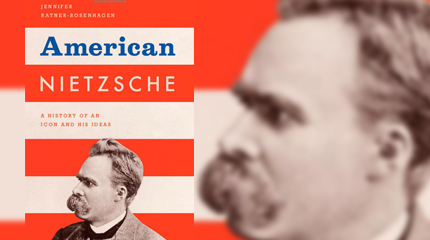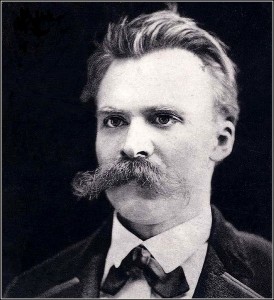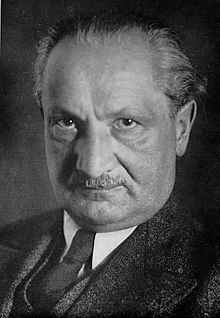 If you haven’t yet read James Livingston’s JAH review of Jennifer Ratner-Rosenhagen’s American Nietzsche, well, what are you waiting for? Here’s a snippet from the introductory paragraph: “This book could rehabilitate the project of intellectual history, which, notwithstanding its recent resurgence—as witness the recent founding of the journal Modern Intellectual History and its flamboyant other, the Society for U.S. Intellectual History—has lately suffered from its understandable urge to interpret the big ideas of famous or influential intellectuals, a small, typically neurotic, and unenviable slice of modern industrial society.”
If you haven’t yet read James Livingston’s JAH review of Jennifer Ratner-Rosenhagen’s American Nietzsche, well, what are you waiting for? Here’s a snippet from the introductory paragraph: “This book could rehabilitate the project of intellectual history, which, notwithstanding its recent resurgence—as witness the recent founding of the journal Modern Intellectual History and its flamboyant other, the Society for U.S. Intellectual History—has lately suffered from its understandable urge to interpret the big ideas of famous or influential intellectuals, a small, typically neurotic, and unenviable slice of modern industrial society.”
You might also be interested in my Reviews in American History essay that looks at both American Nietzsche and Martin Woessner’s Heidegger in America: “How Americans Have Received Nietzsche and Heidegger and Why It Matters.”
I liberate two paragraphs from behind the paywall:
Although Ratner-Rosenhagen and Woessner approach their subjects in similar fashion—especially in that both argue the thinker whose reception they chart was integrated into American social thought in ways that often bore little relation to his actual philosophy—their methodologies indeed diverge in subtle yet important ways. Ratner-Rosenhagen is invested in the history of how American readers felt when reading Nietzsche. By quoting Janice Radway’s aphorism, “reading is not eating,” Ratner-Rosenhagen makes clear that for her, reading is a transformative means of reception. “What made Nietzsche a genius” to the young radicals of the early twentieth century, those like Goldman, “was that his language enabled the reader to feel his ideas” (Ratner-Rosenhagen, p. 155). Likening it to a “romp in the hay,” these readers “described their experiences of reading Nietzsche as intoxicating, bracing, challenging, ennobling. But most of all, the experience taught them about the value of ideas as an experience, and words as a vital form of action” (p. 166). As Nietzsche wrote in The Birth of Tragedy: “The existence of the world is justified only as an aesthetic phenomenon.” Reading Nietzsche was an aesthetic phenomenon that gave meaning to life where God no longer could. Ratner-Rosenhagen’s fascinating interlude chapter, “Devotions”—an analysis of the many letters sent to the Nietzsche archive by Nietzsche’s lay American readers, what she calls “American Nietzsche ephemera”—offers primary source evidence to illustrate her thesis. “The letters provide an opportunity, rare for intellectual historians, to enter the moral worlds of general readers and hear their longings, their ideas about ideas, and their concerns about the modern forces undermining American intellectual life” (p. 197). Whereas most reception historians only empower readers by way of theoretical armatures, Ratner-Rosenhagen attributes agency to readers by way of empirical evidence. This is a remarkable accomplishment, not least because it finally upends Henry May’s half-century-old conventional wisdom that Nietzsche was “too alien” to have had much influence on American social thought.
Woessner attempts to show that Heidegger is not strange to America by arguing that it is Heidegger’s “persona most of all that has had such far-reaching influence in American intellectual life” (Woessner, p. 91). Like Ratner-Rosenhagen, Woessner recommends that intellectual historians be “as interested in the history of thinking as the history of thought” (Woessner, p. 89). But whereas Ratner-Rosenhagen is cognizant of the history of thinking as feeling, Woessner makes sense of it as style. “What Heidegger’s students absorbed, after all, was not so much a specific doctrine or dogma, but a methodology that was rooted in a specific philosophical attitude or style” (Woessner, p. 89). Put differently, Heidegger and his acolytes “privileged the arch conception of the philosopher as an exegetical magician: each sought to place philosophy beyond the purview of mass society, thus ensuring that it remained the province of only those who had ears to hear” (Woessner, p. 89). One can see this style in Heidegger’s student Leo Strauss, who loathed Heidegger’s existential grasping for Being, but mimicked his style of reading and teaching texts. A whole school of American political philosophy emerged from this style, as Strauss and his ubiquitous students, including Allan Bloom, taught a generation of conservatives how to read and write texts at two levels: at a low level that laypeople could understand, and at a lofty level that a natural aristocracy fit to govern could comprehend. One can also see the Heideggerian style, to a lesser extent, in Derrida’s “death of the author” deconstruction, where meaning is found in the reading of the text itself, rather than in the context of its production.
——-
If this isn’t enough, stay tuned for our American Nietzsche roundtable in May, which will features essays by Livingston, Corey Robin, Wilfred McClay, and a response from Ratner-Rosenhagen.



5 Thoughts on this Post
S-USIH Comment Policy
We ask that those who participate in the discussions generated in the Comments section do so with the same decorum as they would in any other academic setting or context. Since the USIH bloggers write under our real names, we would prefer that our commenters also identify themselves by their real name. As our primary goal is to stimulate and engage in fruitful and productive discussion, ad hominem attacks (personal or professional), unnecessary insults, and/or mean-spiritedness have no place in the USIH Blog’s Comments section. Therefore, we reserve the right to remove any comments that contain any of the above and/or are not intended to further the discussion of the topic of the post. We welcome suggestions for corrections to any of our posts. As the official blog of the Society of US Intellectual History, we hope to foster a diverse community of scholars and readers who engage with one another in discussions of US intellectual history, broadly understood.
The Flamboyant Other!
This should be the subtitle for our blog.
Thanks for this sample, Andrew! Very much looking forward to the roundtable.
Fabulous; I really enjoyed reading Tim’s review, look forward to all of this activity surrounding American Nietzsche! As a comparative literature undergrad, my reading of Nietzsche was heavily influenced by the poststructuralist reception, with Foucault’s essay “Nietzsche, Genealogy, History” as the most significant text (we shouldn’t forget the differences between Foucault and Derrida, the latter didn’t share the former’s interest in shaping a “genealogy of the present” nor his investment in a radical politics, at least in the 70s; it could be said Derrida chose Heidegger as his symbolic mentor, while Foucault positioned himself closer to Nietzsche, by way of the history of science of Canguilhem).
I am also intrigued by the reception of Nietzsche in so-called analytic philosophy and how it shakes up our current notions of a strict divide between analytic and continental philosophy. For example, philosophers from Gary Gutting to Brian Leiter–whose website I often visit to get a better grasp of the discipline of philosophy in the US–have written extensively on Nietzsche from an “analytic” perspective (Leiter interestingly admires Foucault and views Deleuze as an important thinker, but sees Derrida as a quack).
Thank you for your work on a vital topic, Andrew.
In unmasking the false pieties of Christianity and the hypocrisies of Western civilization, Nietzsche and Heidegger laid bare the very identity modern America imagined for itself. It is not surprising, then, that Nietzsche and Heidegger were imported into the American culture wars of the 1980s and ’90s, the paradigmatic clash over the fabric of normative America, into which the acids of modernity had burned gaping, irreparable holes.
Yes, that’s where we are. Some of us, anyway. But like savagery, all nihilism has a sameness about it: the difference between acid burns is mostly one merely of degree, so as for false pieties, the “civil” in civilization prefers false pieties to none atall.
One can see this style in Heidegger’s student Leo Strauss, who loathed Heidegger’s existential grasping for Being, but mimicked his style of reading and teaching texts. A whole school of American political philosophy emerged from this style, as Strauss and his ubiquitous students, including Allan Bloom, taught a generation of conservatives how to read and write texts at two levels: at a low level that laypeople could understand, and at a lofty level that a natural aristocracy fit to govern could comprehend.
A few reservations here, although it’s largely accurate. “Mimicked” is pejorative: although Strauss may have gone a bit overboard with the Machiavelli numbering bit, his method of close reading is to understand the writer as he understands himself, an approach many intellectual historians favor. Further, it wouldn’t be fair to say Strauss wrote or taught his students to write esoterically [the philosopher has no wish to rule] as much as to read the great thinkers that way because ever since Socrates, too much truth can be hazardous to your health.
In our own milieu, the English crown hanged Algernon Sidney; Locke published his similar ideas not at all until the Glorious Revolution went his way, and only then anonymously—just in case. And Tom Paine might well have kept his ideas on the Bible to himself, for all the good it did to the reception of his other ideas [some of which weren’t bad].
Acid burns indiscriminately. Allan Bloom’s too, unfortunately.